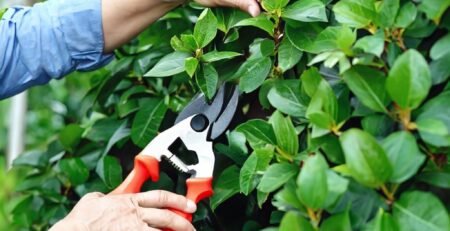Guide: What Makes Leaves Turn Yellow? And Other Houseplant Ailments
In this blog post, we’ll examine some of the most common houseplant ailments, both insect and fungal. If houseplants are neglected, they become susceptible to some pretty nasty problems. Many of them can be easily corrected—others are a bit more challenging. The easiest way to avoid these ailments is to make sure you’re buying clean houseplants from a respected garden center. However, diseases can still develop if the plant is stressed due to undesirable growing conditions.
A common ailment in houseplants is yellowing leaves. While it doesn’t look pretty, yellowing leaves sometimes simply mean the plant has either been under-watered or over-watered. To fix this problem, re-examine your watering schedule and adjust accordingly depending on the houseplant’s needs. Some plants need to be watered strictly a couple times a week. Others can wait between watering for the surface of the soil to dry. It all depends on the type of plant, its location, how warm your house is, and how often it’s being watered. If you’re not sure about the care requirements, bring in a photo and we’ll help you out!
Other ailments might not be so easily cured. The first pest we’ll discuss is mealybug.
Insect Pests
Mealybug
These insects are easily identified as pink, soft-bodied insects covered in a white, cottony material. They feed on a wide variety of plants, which weakens and stunts plants, causes yellowing of the leaves, and defoliation. Citrus mealybugs are the most common types of mealybug found on houseplants; they excrete a liquid called honeydew, which can allow for the development of sooty mold, which we’ll discuss later. These insects are easily spotted on plants; they appear as fluffy, white, cottony clusters.
For small infestations, the plant can often be washed off with warm water to dislodge the mealybugs. Insects and the egg masses can also be wiped off with a cotton swab or cloth dipped in rubbing alcohol. If those methods don’t work, there are a number of chemical products that can effectively take care of mealybug. Insecticidal soaps, horticultural oils, and other products are available in our garden center. Read all labels carefully.
Spider Mites
The next insect pest is the spider mite. These tiny insects are identified by webbing on foliage. However, when the webbing appears, it usually means the mite population is exponential. Spider mites damage foliage by sucking cell contents from the leaves, which shows up as stippling. More severe damage can be identified by leaf yellowing and leaf drop, as well as burned edges or a leather-like texture on leaves. Spider mites can be taken down by chemical applications of products such as Neem Oil, products contain Pyrethrins, and horticultural oils.
Aphids
Aphids are tiny insects, nearly invisible to the naked eye. Nymphs and adult aphids all feed on plant juices and attack leaves, stems, buds, flowers/fruit, and roots. To determine if you have aphids, look for misshapen, curling, stunted, or yellowing leaves. The aphids will also excrete a sticky substance called “honeydew”, which is a sign they’ve been sucking sap. This honeydew can sometimes encourage sooty mold, just like the excretion from mealybug. Like the other insect pests, Neem Oil, insecticidal soap, and horticultural oils will take care of aphids. They can also be sprayed with cold water to dislodge them. A diluted solution of water and dish soap is also an effective method for getting rid of them. Re-apply the dilution every 2-3 days for 2 weeks.
Scale
There are three types of scale insects: armored scale, soft scale, and mealybug. Armored scale are the most difficult to get rid of once they’re established. Plants damaged by scale will look withered and sickly. They may also have traces of sticky sap, called honeydew, or the plant may have black fungus on the leaves and stems. Scales are difficult to get rid of if they are left uncontrolled, but there are numerous methods for taking care of the infestation. One method is to gently pick off or scrub them loose from the leaves and stems. For lightly infested plants, applying a swab doused in rubbing alcohol is another possibility.
Thrips
Thrips are tiny, slender insects with fringed wings. The adults, less than 1/16 an inch in length, are very difficult to see without a magnifying glass. Signs of thrip damage include a silvery or speckled appearance similar to mite damage. Both the adults and the nymphs (immature stage) feed by scraping surface cells to suck on plant sap. Leaves may also drop early, and if the flowers are fed on, they may drop without opening. The flowers can also be streaked or distorted from thrips feeding.
To control thrips, rinse leaves with water and spray the plants with insecticidal soap. The insecticidal soap should contain an ingredient called spinosad to be effective in controlling a thrip infestation.
Whitefly
Whiteflies are small flies, about 1/10 to 1/16th inch long, that resemble moths. These pests also feed by sucking sap, damaging plants similarly to aphids. Leaves will turn yellow and die, and the plant may become stunted. They also excrete honeydew, like aphids. Rinsing the plant and spraying insecticidal soap will help control whitelies.
Fungus
Leaf Spot
Leaf spot is a fungus that can develop on outdoor plants as well as houseplants and it often arises when the foliage is watered instead of the soil. It is identified by brown spots ringed in yellow on plant leaves. Damaged leaves should be removed from the plant and discarded to prevent it from spreading. Hold back on watering until the plant is dry, and be sure to water at the soil level, not on the leaves.
Powdery Mildew
A fast-spreading fungus, powdery mildew is characterized by circular white, powdery spots on foliage leaves. Over time, if left unchecked, the mildew will ultimately kill your houseplants. Powdery mildew can be found outside, but it’s more common indoors due to conditions. It develops due to poor air circulation, low light, and thrives in drier conditions. Common plants affected by this fungus are African violets, kalanchoe, begonias, ivy, and jade.
The substance wipes off easily with your finger or with a cloth. Additionally, don’t mist plants and avoid the foliage when watering. Infected plants should be isolated to prevent the fungus from spreading to other plants in your home. Fungicides are an effective method for controlling powdery mildew. Read all labels carefully and apply fungicide outside.
Root Rot
Your houseplant’s leaves are yellow and dull, and the plant as a whole isn’t looking too healthy. Then the leaves wilt and fall off, and suddenly, the plant is completely dead. More than likely your houseplant has been stricken by root rot. Root rot is caused by a fungus and develops when the roots sit in too much water. Soil that doesn’t drain properly is a big culprit, as well as containers that have no drainage holes in the bottom. Both of these scenarios provide the perfect environment for fungus to develop.
Can the plant be saved? To answer this, remove the plant from its pot and examine the roots. If all of them are black and mushy, unfortunately it’s too late to save it and it should be thrown out. But if some white, firm, healthy roots still exist, the plant is still salvageable. Clean the roots gently under running water and strip away any black and mushy roots with a pair of scissors. Trim healthy, but slightly rotting, roots just above the damaged area. Re-pot the plant in fresh potting soil and be sure to sterilize your scissors with 1 part bleach to 3 parts water to prevent the fungal spores from spreading to other plants. Make sure the new pot you’ve chosen has drainage holes to avoid rotting the healthy roots.
To prevent root rot, take the following precautions:
- Don’t over-water. Only water when the top 1-2 inches of soil is dry.
- Give plants plenty of room to grow. Be sure to re-pot into bigger containers when necessary. Plants that are in too-small containers can be susceptible to root rot, as the roots will cause drainage issues.
- Make sure your plants get enough light. Too dark conditions will keep the soil too moist.
- Grow new plants in loose, healthy soil. Soil that is too dense won’t drain well and the plant may inadvertently get over-watered.
Sooty Mold
Finally, sooty mold is a mold that derives from honeydew, a secretion left by pests such as aphids and scale. The honeydew makes the leaves sticky, allowing the sooty mold spores to land on the leaves and spread. The mold looks like the name implies—the twigs, branches, or leaves will be covered in a grimy, black soot. Since sooty mold develops as a result of pests, the best way to get rid of sooty mold is to take care of the pest problem. Determine which pest you have and take the appropriate steps to get rid of it. Sooty mold washes off easily, or you can apply Neem Oil to take care of both the insect pest and the fungus.
In conclusion, if you’re having trouble identifying your houseplant’s ailment, bring in a photo or a bagged leaf to our experts. We’ll help you diagnose it and recommend the appropriate solution to get your plant healthy again!






